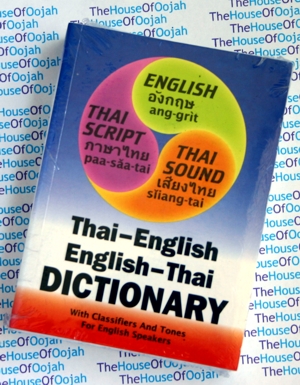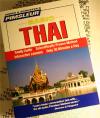Thai-English English-Thai Dictionary

Thai- English English-Thai DictionaryIncludes Classifiers and Tones for English speakers More Thai Language Learning click here |
 |
Thai- English English-Thai Dictionary - Softcover 982 pages This practical Thai English, English Thai dictionary is designed to help English speakers communicate in Thai, whether or not you can read the Thai alphabet. All Thai words are listed in both Thai script and an easy-to-learn, English-like pronunciation system that fully expresses Whether you are visiting Thailand for a short while or living there permanently, you will find most of the vocabulary used in everyday life, including basic medical, cultural, political and scientific terms. Completely updated and expanded with more than 28,000 entries and 36,000 definitions, as well as a new, large font size that is easy on the eyes, this next-generation Paiboon dictionary now lists over 15,000 classifiers along with nouns. There is an extensive intro to speaking and writing Thai, with a handy font chart to help you read signs and newspaper headlines. It's the one dictionary you can really use! And it comes in a portable size that is easy to carry around Thailand. About the Thai LanguageThai is the national and official language of Thailand and the mother tongue of the Thai people, Thailand's dominant ethnic group. Thai is a member of the Tai group of the Tai-Kadai language family. The Tai-Kadai languages are thought to have originated in what is now southern China, and some linguists have proposed links to the Austroasiatic, Austronesian, or Sino-Tibetan language families. It is a tonal and analytic language. The combination of tonality, a complex orthography, relational markers and a distinctive phonology can make Thai difficult to learn for those who do not already speak a related language. is the national and official language of Thailand and the mother tongue of the Thai people, Thailand's dominant ethnic group. Thai is a member of the Tai group of the Tai-Kadai language family. The Tai-Kadai languages are thought to have originated in what is now southern China, and some linguists have proposed links to the Austroasiatic, Austronesian, or Sino-Tibetan language families. It is a tonal and analytic language. The combination of tonality, a complex orthography, relational markers and a distinctive phonology can make Thai difficult to learn for those who do not already speak a related language. Thai is mutually intelligible with Lao. The Thai alphabet is derived from the Khmer alphabet, which is modeled after the Brahmic script from the Indic family. The language and its alphabet are closely related to the Lao language and alphabet. Most Laotians are able to read and understand Thai, as more than half of the Thai vocabulary, grammar, intonation, vowels and so forth are common with the Lao language. Much like the Burmese adopted the Mon script (which also has Indic origins), the Thais adopted and modified the Khmer script to create their own writing system. While the oldest known inscription in the Khmer language dates from 611 CE, inscriptions in Thai writing began to appear around 1292 CE. Notable features include: 1. It is an abugida script, in which the implicit vowel is a short /a/ in a syllable without final consonant and a short /o/ in a syllable with final consonant. 2. Tone markers are placed above the consonant just before the vowel sound of the syllable. 3. Vowels sounding after a consonant are nonsequential: they can be located before, after, above or below the consonant, or in a combination of these positions. There is no universal standard for transcribing Thai into the Latin alphabet. For example, the name of King Rama IX, the present monarch, is transcribed variously as Bhumibol, Phumiphon, phuuM miH phohnM, or many other versions. Guide books, text books and dictionaries may each follow different systems. For this reason, most language courses recommend that learners master the Thai alphabet. What comes closest to a standard is the Royal Thai General System of Transcription (RTGS), published by the Thai Royal Institute only in Thai. This system is increasingly used in Thailand by central and local governments, especially for road signs. Its main drawbacks are that it does not indicate tone or vowel length. It is not possible to reconstruct the Thai spelling from the RTGS transcriptions. The ISO published an international standard for the transliteration of Thai into Roman script in September 2003 (ISO 11940) . By adding diacritics to the Latin letters, it makes the transcription reversible, making it a true transliteration. This system is intended for academic use and is hardly ever used in Thailand for the common publicStandard Thai, also known as Central Thai or Siamese, is the official language of Thailand, spoken by about 65 million people including speakers of Bangkok Thai . Khorat Thai is spoken by about 400,000 (1984) in Nakhon Ratchasima; it occupies a linguistic position somewhere between Central Thai and Isan on a dialect continuum, and may be considered a variant or dialect of either. In addition to Standard Thai, Thailand is home to other related Tai languages, including: * Isan (Northeastern Thai), the language of the Isan region of Thailand, considered by some to be a dialect of the Lao language, which it very closely resembles (although it is written in the Thai alphabet). It is spoken by about 15 million people (1983). Many of these languages are spoken by larger numbers outside of Thailand. Most speakers of dialects and minority languages speak Central Thai as well, since it is the language used in schools and universities all across the kingdom. Numerous languages not related to Thai are spoken within Thailand by ethnic minority hill tribespeople. These languages include Hmong-Mien (Yao), Karen, Lisu, and others. Standard Thai is composed of several distinct registers, forms for different social contexts: * Street Thai : informal, without polite terms of address, as used between close relatives and friends. Many Thais can speak at only the first and second levels, though they will understand the others. |
Thai- English English-Thai Dictionary - Softcover 982 pages |
| Retail: | $29.95 |
| On Sale: | $28.95 |
| You Save: | 4% |
| Stock Info: | Out Of Stock |
| Receive In Stock Notification |

 0 Items (Empty)
0 Items (Empty)
